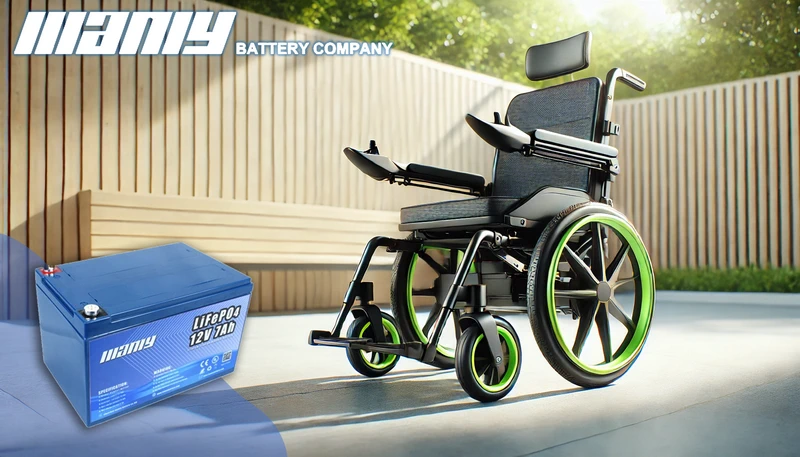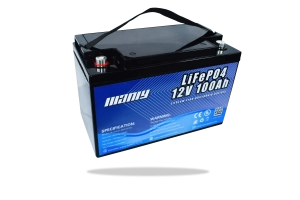Do All Electric Wheelchairs Have Lithium Batteries?
Table of Contents
- Do All Electric Wheelchairs Have Lithium Batteries?
- Types of Batteries Used in Electric Wheelchairs
- Advantages of Lithium Wheelchair Batteries
- Challenges with Lithium Wheelchair Batteries
- Effective Maintenance and Replacement Strategies for Wheelchair Batteries
- The Future of Wheelchair Battery Technology: Trends and Innovations
- Conclusion
- Learn More About Battery

Types of Batteries Used in Electric Wheelchairs
When selecting an electric wheelchair, one of the most crucial components to consider is the battery type. The battery not only determines how far the wheelchair can travel on a single charge but also impacts the overall weight, maintenance, and usability of the wheelchair. In this section, we'll explore the different types of batteries commonly used in electric wheelchairs: 12v wheelchair battery, Gel, AGM, and lithium wheelchair batteries.12v Wheelchair Battery
The 12v wheelchair battery is a staple in many electric wheelchair designs. This type of battery is valued for its reliability and consistent performance. Typically, two 12-volt batteries are connected in series to provide a 24-volt system, essential for the power requirements of most wheelchairs. These batteries are often lead-acid type, known for their durability and cost-effectiveness.Gel Batteries
Gel batteries are a type of sealed lead-acid battery, but with a twist: they use a gelified electrolyte. This gel composition helps prevent leaks and is less prone to damage if the battery casing is compromised. Gel batteries are also more stable, can handle lower temperatures, and are less likely to sulfate compared to their standard lead-acid counterparts. For wheelchair users, this means less maintenance and a reduced risk of unexpected power loss.AGM (Absorbed Glass Mat) Batteries
AGM batteries represent a subgroup of lead-acid batteries where the electrolyte is absorbed into a fiberglass mat. This design makes the batteries spill-proof and provides superior performance in terms of power output and charge cycles. AGM batteries are more efficient at charging and discharging than traditional lead-acid batteries, making them a preferred choice for users who need a reliable power source that can handle frequent charging cycles without deteriorating too quickly.Lithium Wheelchair Batteries
Lithium wheelchair batteries are becoming increasingly popular due to their lightweight and high efficiency. These batteries can charge faster and last longer than lead-acid batteries, providing more range and a lighter weight, which makes the wheelchair easier to transport and maneuver. Moreover, lithium batteries do not require the same level of maintenance as lead-acid batteries, such as regular watering. However, they are usually more expensive upfront and may require special care when charging to ensure longevity.Technical Specifications
Each battery type comes with its own set of specifications. 12v wheelchair batteries typically provide a solid balance of performance and affordability but may be heavier and require more frequent replacement. Gel and AGM batteries offer better performance in terms of longevity and maintenance, with AGM usually being the more robust option in cold weather. Lithium wheelchair batteries, while the most expensive, offer the highest energy density, resulting in lighter weight and longer life spans, making them a worthwhile investment for active users.In summary, the choice of battery in an electric wheelchair impacts not only the wheelchair's performance but also its operational costs and user experience. Whether you opt for the economical 12v wheelchair battery, the durable Gel or AGM, or the high-performing lithium wheelchair batteries, understanding these options will help you make an informed decision tailored to your specific needs.Advantages of Lithium Wheelchair Batteries
Lithium batteries are revolutionizing the mobility industry, particularly in the realm of electric wheelchairs. Known for their efficiency and longevity, lithium wheelchair batteries offer significant advantages over traditional battery technologies like lead-acid. This chapter explores why these batteries are becoming the preferred choice for those seeking dependable, lightweight, and environmentally friendly options in electric wheelchairs.Longevity and Reliability
One of the standout benefits of lithium wheelchair batteries is their longevity. Unlike traditional batteries, which may require frequent replacements, lithium batteries can last significantly longer. They have a higher number of charge cycles, often up to 1000-2000 full charge cycles before their capacity begins to degrade. This means that a lithium battery could potentially last for several years without needing a replacement, making it a cost-effective solution in the long run.Additionally, lithium batteries maintain their charge efficiency better than their counterparts. They can discharge up to 80-90% of their capacity without significant loss in power output, ensuring that the wheelchair operates at a high performance for longer periods. This reliability is crucial for users who depend on their electric wheelchairs for daily mobility.Weight Advantages
The weight of the battery is a critical factor in the design and functionality of electric wheelchairs. Lithium wheelchair batteries are up to 30% lighter than traditional lead-acid batteries. This reduction in weight contributes to a lighter wheelchair, which is easier to maneuver and transport. For users, this means enhanced mobility and less physical strain, particularly when loading and unloading the wheelchair from vehicles or navigating through tight spaces.Environmental Impact
Environmental sustainability is increasingly becoming a priority, and lithium batteries score well on this front too. They are more environmentally friendly than lead-acid batteries because they contain no hazardous lead and have a lower risk of acid leaks. Moreover, the longer lifespan of lithium batteries reduces the frequency of battery replacements and the associated environmental burden of waste and recycling.Increasing Preference in the Mobility Sector
The shift towards lithium technology in the mobility sector is driven not only by the benefits mentioned above but also by broader technological advancements and regulatory factors. Innovations in lithium battery technology have led to safer, more efficient batteries that meet the rigorous demands of electric wheelchair users. Regulatory pushes for greener technologies also play a role, as lithium batteries align better with environmental guidelines compared to lead-acid batteries.In conclusion, lithium wheelchair batteries represent a superior choice for modern electric wheelchairs, driven by their long life, lightweight characteristics, and minimal environmental impact. As technology continues to advance, we can expect these batteries to play an even greater role in enhancing the independence and quality of life for individuals relying on electric mobility aids. The ongoing development and adoption of lithium batteries are set to transform the electric wheelchair market, making it more accessible, sustainable, and user-friendly.Challenges with Lithium Wheelchair Batteries
While lithium wheelchair batteries offer numerous advantages, they also come with their own set of challenges that can impact user choice and satisfaction. This chapter delves into the limitations and complications associated with these batteries, exploring aspects like cost, compatibility, and scenarios where alternative battery types may be more suitable.Cost Concerns
One of the primary deterrents for many users considering lithium wheelchair batteries is the initial cost. Lithium batteries are generally more expensive than their lead-acid or gel counterparts. This higher upfront cost can be prohibitive for individuals or healthcare facilities with limited budgets. Although the long-term benefits, such as fewer replacements and lower maintenance, can offset the initial expense, the initial investment remains a significant barrier for widespread adoption.Moreover, the maintenance and replacement of lithium batteries, though less frequent, can also be more costly. Specialized equipment and knowledge are required to safely handle and dispose of lithium batteries, adding to the overall cost of ownership.Compatibility Issues
Compatibility is another significant challenge with the adoption of lithium batteries in electric wheelchairs. Many existing wheelchair models are designed to operate optimally with traditional battery types, such as lead-acid. Retrofitting these models to accommodate lithium batteries can require extensive modifications, not just in the battery housing but also in the electronic control systems to handle different voltages and currents. This can complicate the transition to lithium technology, particularly for users who are not ready to purchase new wheelchairs but are looking to upgrade their existing battery systems.Suitability in Certain Scenarios
While lithium batteries excel in many use-cases due to their lightweight and high-energy density, there are scenarios where other types of batteries might be more suitable. For example, in extremely cold environments, lithium batteries can underperform as low temperatures can affect their chemical reactions, leading to reduced power output and efficiency. In such cases, gel or AGM (Absorbent Glass Mat) batteries, which are less susceptible to cold temperatures, might be a better choice.In addition, for users who require only minimal use of their electric wheelchair or for those who prioritize certain performance characteristics such as extreme durability under rough conditions, the cost-benefit ratio of lithium may not be as favorable. Here, the more robust nature of traditional batteries could be deemed more appropriate despite their heavier weight and lower efficiency.Effective Maintenance and Replacement Strategies for Wheelchair Batteries
Maintaining and replacing the batteries of an electric wheelchair are crucial for ensuring optimal performance and longevity of your mobility aid. This chapter provides practical advice and tips on how to care for and when to replace the batteries in your electric wheelchair, focusing on maximizing their lifespan and ensuring continuous, reliable mobility.Maintaining Different Types of Wheelchair Batteries
The maintenance needs of wheelchair batteries can vary significantly depending on the type of battery used. Gel batteries, AGM batteries, and lithium wheelchair batteries all have different care requirements:- Gel batteries require very little maintenance as they are sealed and do not need watering. However, it's crucial to keep them charged and avoid completely depleting the battery charge, as this can significantly shorten their lifespan.
- AGM (Absorbent Glass Mat) batteries also do not need additional water and are more resistant to vibrations than gel batteries. They should be kept fully charged and stored in a cool, dry place when not in use to prevent sulfation, which can degrade the battery's capacity.
- Lithium wheelchair batteries are the most maintenance-friendly among all types, with a high energy density and no memory effect, meaning they don’t require complete discharge before recharging. Nevertheless, it's important to use a compatible charger and avoid exposing them to extreme temperatures, as heat can cause lithium batteries to degrade faster.
Choosing and Replacing Wheelchair Batteries
When it comes time to replace your wheelchair’s battery, several factors should be considered to choose the right battery:- Battery Compatibility: Ensure that the replacement battery is compatible with your wheelchair model. Voltage and capacity should match the manufacturer's specifications to avoid any issues with performance or damage to the wheelchair's motor or electronics.
- Brand and Quality: Opt for high-quality batteries from reputable manufacturers. Cheaper alternatives may save money upfront but typically offer shorter lifespans and less reliable performance, leading to more frequent replacements.
- Type of Battery: Consider the type of battery that best suits your needs. Lithium batteries, while more expensive, provide longer life and require less frequent charging. If budget constraints are a concern, gel or AGM batteries can be good alternatives.
- Warranty and Support: Check the warranty offered with the battery. A longer warranty period is often an indicator of a better-quality battery. Additionally, purchasing from a supplier that offers good customer support can be beneficial in case of issues during the battery’s lifespan.
- Turning off the wheelchair and removing the battery connections.
- Safely removing the old battery and disposing of it according to local regulations, as batteries contain materials that can be harmful to the environment.
- Installing the new battery, ensuring all connections are secure and correct.
The Future of Wheelchair Battery Technology: Trends and Innovations
As we move forward, the field of battery technology continues to evolve, offering new possibilities and improvements for electric wheelchair users. This chapter explores the significant technological advancements in the battery sector and anticipates future trends that may redefine mobility for individuals relying on electric wheelchairs.Technological Advancements in Battery Technology
In recent years, lithium wheelchair batteries have made a notable impact due to their efficiency and longevity. Unlike traditional 12v wheelchair battery systems or other chemistries like Gel and AGM, lithium batteries offer a superior energy-to-weight ratio, which is crucial for mobility applications. They charge faster, last longer, and require less frequent replacement, making them a highly beneficial investment for wheelchair users.Beyond lithium, researchers are exploring other innovative battery technologies. Solid-state batteries, for instance, promise even greater safety and energy density. These batteries replace the liquid or gel electrolytes with a solid counterpart that is less prone to leaking and can withstand higher temperatures without degrading. Such advancements could further improve the safety and performance of wheelchair batteries.Predicting Future Trends in Wheelchair Batteries
Looking ahead, the future of wheelchair batteries is likely to be shaped by several key factors:- Sustainability: As global emphasis on environmental impact increases, there is a push towards more sustainable battery technologies. Innovations like battery recycling programs and the development of bio-degradable battery components are gaining traction. These efforts aim not only to reduce the ecological footprint but also to enhance the circular economy within the battery industry.
- Integration with Renewable Energy: With the rise of renewable energy sources, future electric wheelchairs might incorporate solar panels or other energy-harvesting technologies to extend battery life and reduce dependency on traditional charging methods. This integration could be particularly beneficial in enhancing the autonomy of wheelchair users, allowing for greater mobility without the frequent need for recharging.
- Smart Battery Management Systems (BMS): Advances in electronics and software have led to the development of smarter BMS that optimize battery life and performance. Future wheelchairs might employ BMS that can predict battery health and maintenance needs, adjust power usage based on travel patterns, and improve overall battery efficiency.
- Customization and User-Specific Design: As technology becomes more adaptable, future battery systems may offer more customization options. Batteries could be designed to meet the specific needs of individual users, considering factors like typical daily use, weight requirements, and even climate conditions.
Conclusion
As we have seen, the choice of battery not only affects the performance and efficiency of electric wheelchairs but also influences the user's independence and quality of life. The ongoing advancements in battery technology, particularly the shift towards more sustainable and high-performing options like lithium wheelchair batteries, promise to further enhance these devices. With innovations such as smart battery management systems and integration with renewable energy sources on the horizon, the future of wheelchair batteries looks bright. Users can look forward to wheelchairs that are more powerful, durable, and environmentally friendly, transforming mobility and accessibility for many.




















